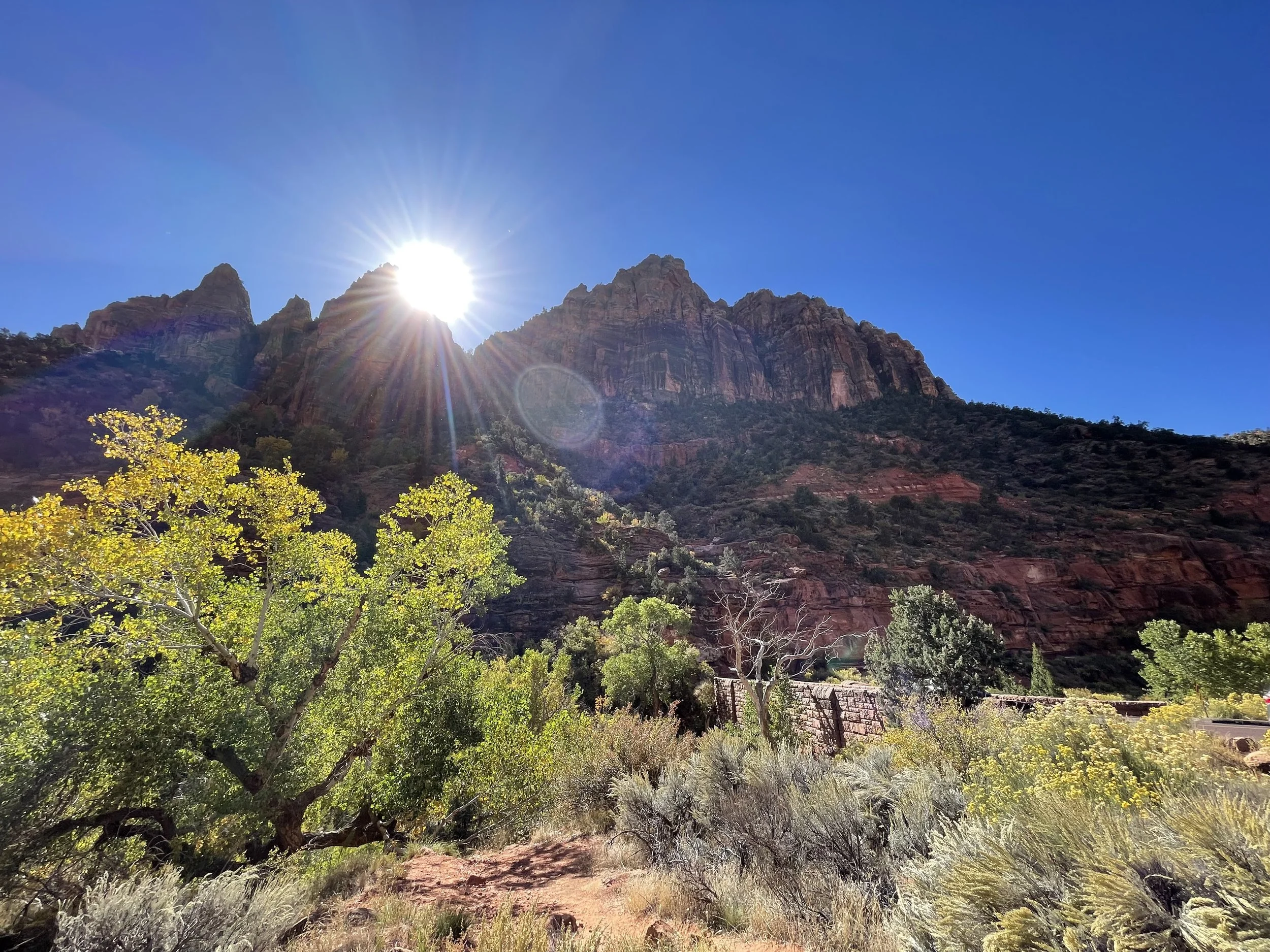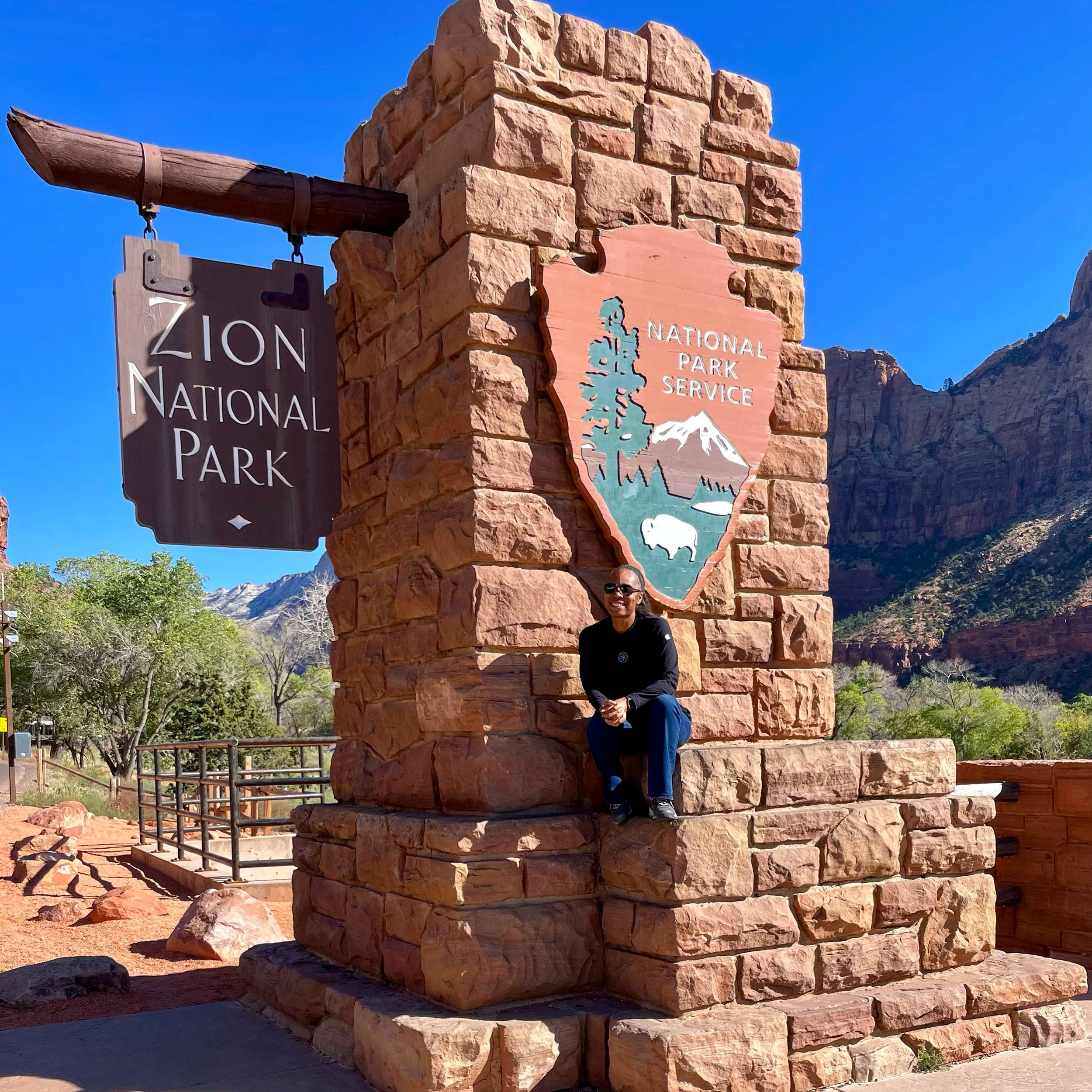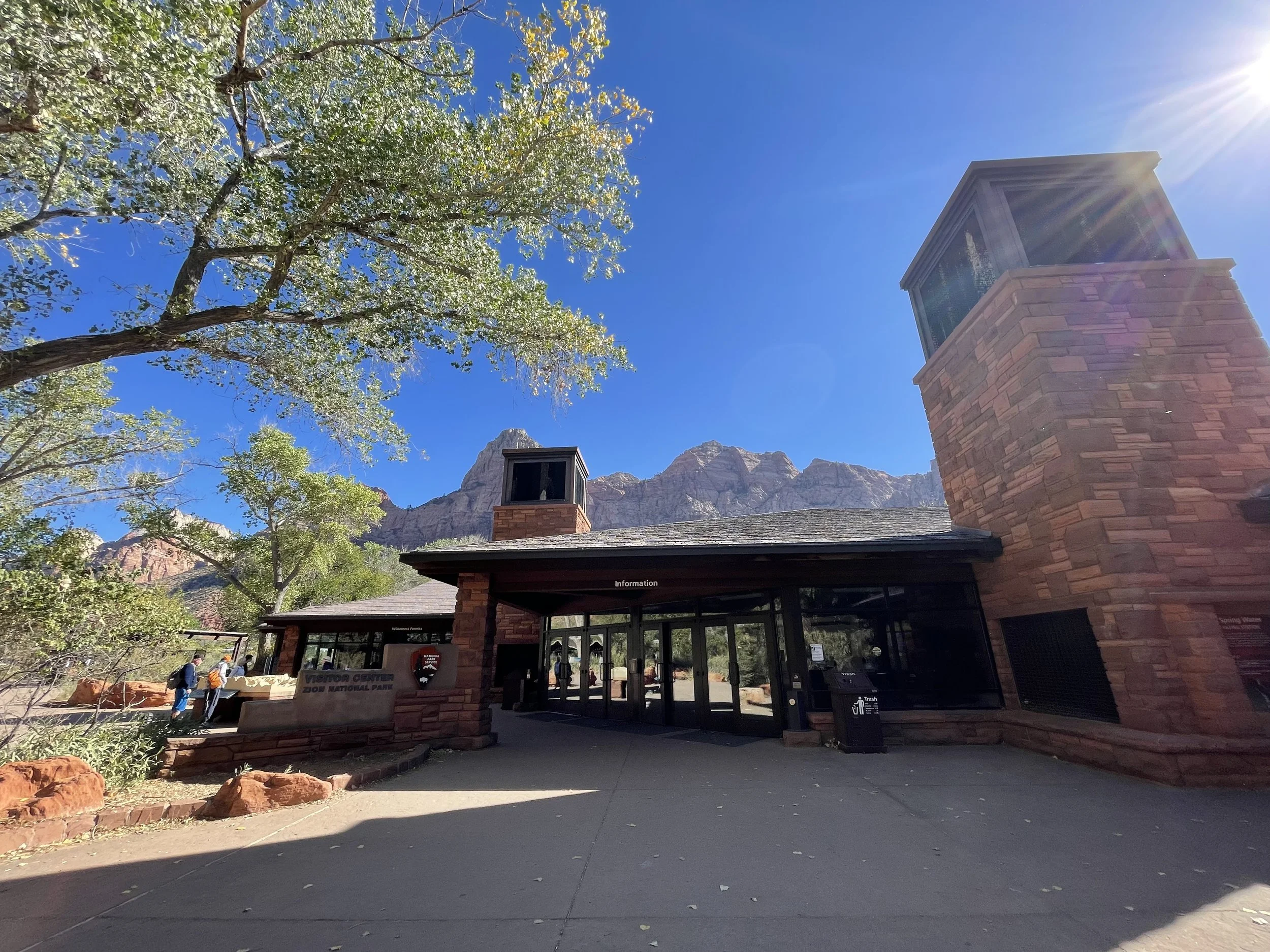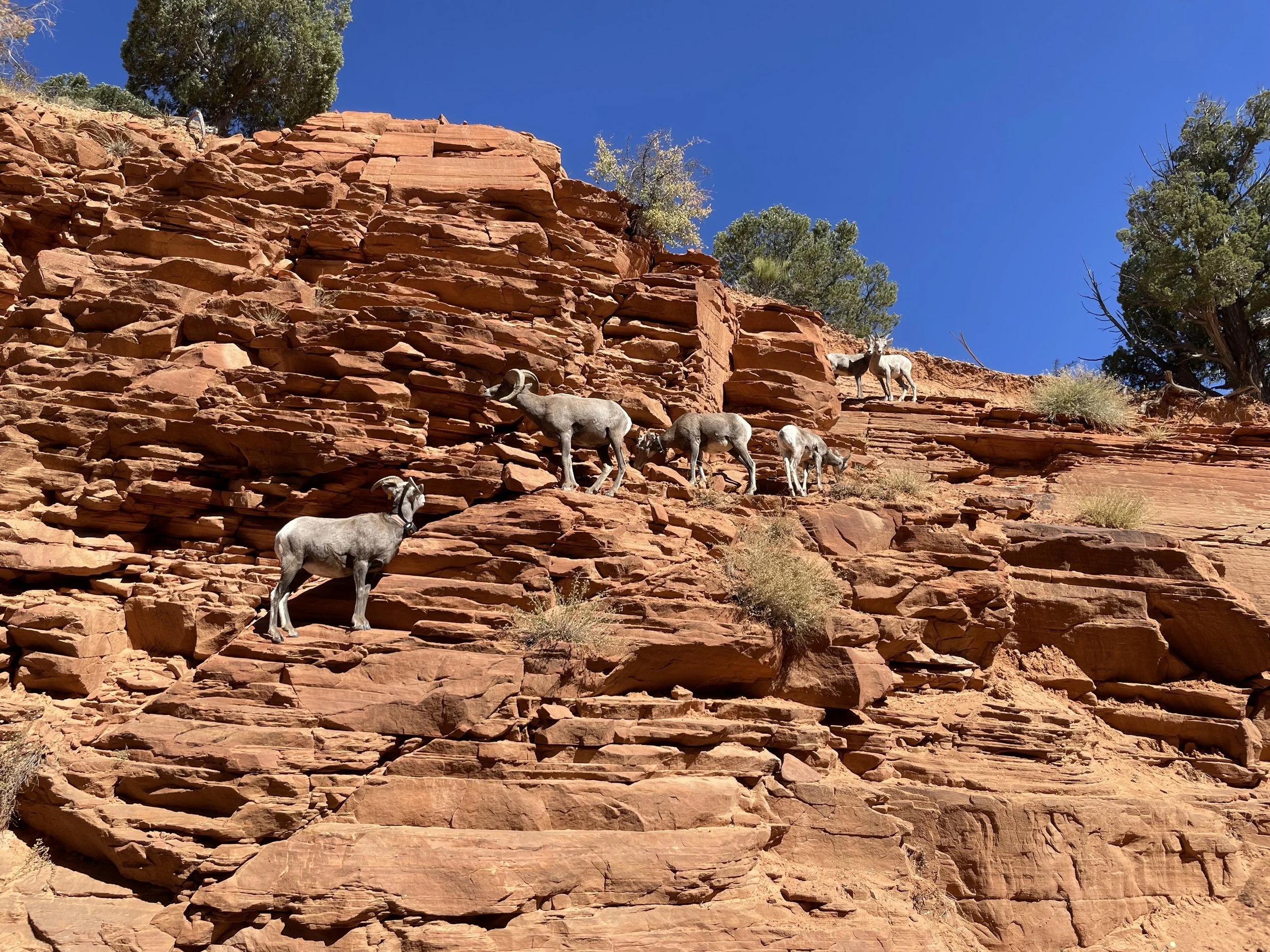#15 Zion National Park, Utah
My visit to Zion National Park was completely unplanned. Originally, I was headed to Great Basin National Park, but a jackknifed semi-truck brought traffic to a standstill. With no sign of it clearing up anytime soon, my Dad suggested a detour—why not head to Zion instead?
That’s the great thing about Las Vegas: within just a few hours’ drive, you have access to several national parks. Zion, being one of the most well-known and accessible, became our new destination.
Once past the traffic, the journey to Zion was beatiful. We drove through canyons, small desert towns, and stretches of open road. As we neared the park, traffic thickened, confirming we were close. By the time we reached the entrance, cars were nearly at a standstill. I took advantage of the slow-moving line to hop out and snap my obligatory photo by the Zion National Park sign.
First Impressions & Visitor Center
While Zion’s beauty is undeniable, my visit wasn’t the most enjoyable. The sheer number of visitors made it difficult to truly appreciate the park’s tranquility.
It took me 45 minutes just to find parking at the Zion Canyon Visitor Center. Desperate, I had to temporarily park in a handicap spot while my Dad stayed in the car, ready to move it, if needed. Inside, the crowds persisted—there was even a long wait at the passport stamp station as one visitor meticulously stamped multiple books. I’ll admit, the experience tested my patience.
Once we escaped the congestion, we drove the scenic roads through the park, stopping at overlooks to take in the incredible views. Zion is undoubtedly stunning, but if I return, it will be during the off-season. I visited on a Tuesday in October, yet it was still overwhelmingly busy.
About Zion National Park
Located in southwestern Utah, Zion National Park is famed for its towering red rock cliffs, dramatic slot canyons, and scenic river valleys. Established in 1919 as Utah’s first national park, Zion spans 229 square miles (593 km²).
The park’s crown jewel is Zion Canyon, a 15-mile gorge carved by the Virgin River. With canyon walls soaring up to 2,000 feet (610 meters), it boasts some of the most spectacular landscapes in the U.S.
Popular Hikes & Attractions
Angels Landing (Permit Required)
Best for thrill-seekers and experienced hikers.
A 5.4-mile roundtrip hike featuring steep switchbacks and a narrow ridge with sheer drop-offs.
The Narrows (Best for wading through water)
A hike through the Virgin River, where you’ll walk between towering canyon walls. Water levels vary, so check conditions before setting out.
Emerald Pools (Easy to Moderate)
Great for families and casual hikers.
Leads to a series of waterfalls and pools, with the Lower Pool being the easiest and the Upper Pool requiring more effort.
Observation Point (Epic Views)
A strenuous 8-mile roundtrip hike offering panoramic views of Zion Canyon, often considered better than Angels Landing—without the crowds.
Canyon Overlook Trail (Short & Stunning)
A 1-mile roundtrip hike with one of the best viewpoints in Zion, requiring less effort than longer trails.
Park Fees & Shuttle System
Entrance Fees:
Private Vehicle: $35 (valid for 7 days)
Motorcycle: $30
Per Person (walk-in or bicycle): $20
Annual Pass: $80 (includes access to all U.S. national parks)
Shuttle System (April – November):
To reduce congestion, private vehicles are prohibited on Zion Canyon Scenic Drive during peak season. Instead, visitors must use the free shuttle system, which runs every 5–10 minutes between the Visitor Center and major trailheads.
Best Photo Spots in Zion
Zion National Park Entrance Sign – A must-have photo.
Canyon Overlook Trail – Stunning panoramic views.
Angels Landing – A daring yet breathtaking summit shot.
The Narrows – Unique perspective with towering canyon walls.
Court of the Patriarchs – A quick stop with dramatic rock formations.
Zion-Mount Carmel Highway – A scenic drive featuring tunnels and switchbacks.
Where to Stay in & Around Zion
Lodging Inside the Park
Zion Lodge
The only hotel inside the park, located along Scenic Drive.
Offers cabins, hotel rooms, and suites.
Reservations fill up months in advance, especially during peak season.
Camping Inside Zion
South Campground (March – November)
Near the Visitor Center; reservations required.
Watchman Campground (Open year-round)
Offers tent and RV sites, some with electric hookups; reservations highly recommended.
Lava Point Campground (Summer only)
First-come, first-served sites; a more remote experience.
Lodging Outside the Park
Springdale, UT (5 min from Zion’s entrance)
Closest town with hotels, restaurants, and shuttle access.
Options: Cliffrose Lodge (luxury), Zion Park Motel (budget), Cable Mountain Lodge (great views).
Hurricane, UT (30 min from Zion)
More affordable hotels and vacation rentals.
Good for road-trippers visiting multiple parks.
St. George, UT (1 hour from Zion)
A larger city with hotels, dining, and shopping.
Ideal for those visiting Zion, Bryce Canyon, and the Grand Canyon.
Things to Consider When Visiting Zion
Best Time to Visit
Fall (Sept – Nov): Cooler weather, fewer crowds.
Spring (Mar – May): Beautiful wildflowers, but higher river levels.
Summer (Jun – Aug): Hot (100°F+) and extremely crowded.
Winter (Dec – Feb): Less crowded, though some trails may be icy.
How to Avoid Crowds
Visit early (before 9 AM) or late (after 3 PM).
Travel in the off-season (winter or late fall).
Explore lesser-known trails (Kolob Canyons, East Rim).
Permits & Restrictions
Angels Landing now requires a permit. Apply online in advance.
The Narrows may close after heavy rain due to flash flood risks.
No drones allowed in the park.
Safety Tips
Stay hydrated—Zion gets extremely hot.
Wear sturdy hiking shoes; trails can be steep and rocky.
Check weather conditions—flash floods are a real danger in slot canyons.




